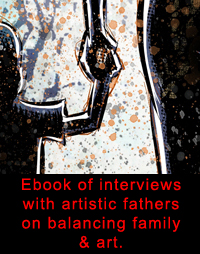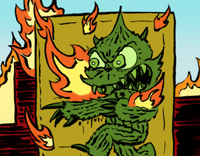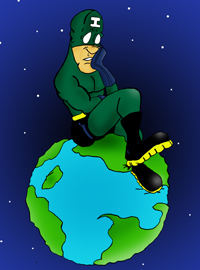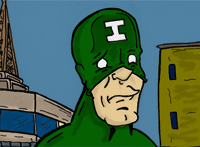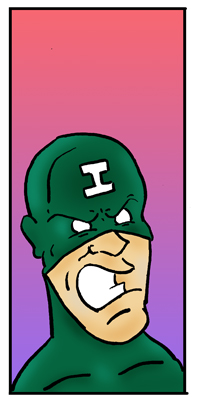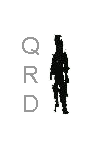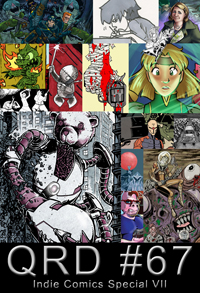
January 2014
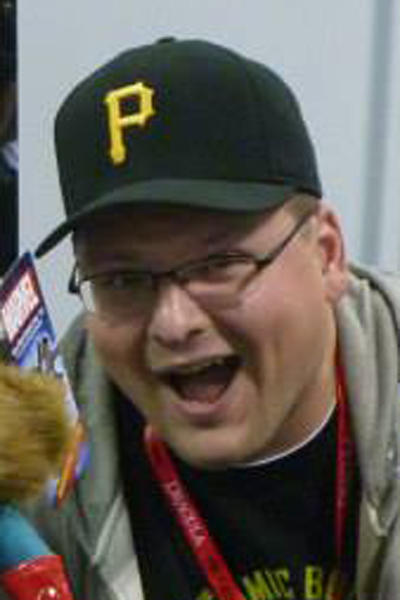
City: Pittsburgh, PA
Comics: Incrediman, Walrus
Websites: www.incredimancomix.com, www.silbermedia.com/walrus
QRD – How old were you when you first got into comics & did you always stick with them or did you come back to them?
Jared – My first comic book is the same age as me, Marvel Two-In-One #61 is cover dated March of 1980, the same month when I was born. Comics, namely superhero comics have been there with me from the start. Certain attitudes & reading habits may have changed here & there, but I never lost interest in them.
QRD – What was the first comic book you ever bought?
Jared – I don’t recall the exact first comic that I ever bought on my own, but the earliest one that sticks out to me is Superman #22. I can still remember seeing it on the spinner rack. It’s an all green cover. Superman is wearing an executioner’s hood & holding a big chunk of Kryptonite. The word balloons on the cover have Superman saying, “You’re responsible for the deaths of a billion beings…for that you must DIE!” I can still remember just thinking how bad ass it looked. It was a pretty crazy story, especially when you’re 7 & hadn’t read the previous issues leading up to that particular one.
QRD – How old were you when you put out your first comic?
Jared – Not counting various comic strips, I finally put out my first proper comic book when I was 29. I had taken a detour from creating comics after high school to pursue other ways of storytelling (movies). When it was evident that was not going anywhere I started working on my current series Incrediman Comix & Stories.
I was very, very slow when I finally started making comics, I began writing the first issue when I was 26 & did not have it completed & ready for print until I was 28. It ended up sitting for almost a year until I was able to get it printed.
QRD – What decade do you think produced the best comics?
Jared – From the perspective of an American comic book fan I have to say the 1960s produced the best comics. Here we are 50 years later & those characters & stories are still the main thrust of the comics industry. Their influence can be seen on pert near everything these days & not just in the comics industry, all over pop culture. Politics aside, that’s some impressive staying power.
QRD – Why comics instead of just writing or drawing?
Jared – Making comics instead of just writing or just drawing just made sense. Honestly, just one or just the other was never a consideration. It was always comics.
QRD – Do you see mini-comics & indie comics as paths to mainstream comics or as their own unique media?
Jared – The boring, but honest answer is “a bit of both”. Growing up, there were ash cans. In those days, they sort of acted like the gnarly self-produced cassette tapes of comics. They were a cheap & easy way to get comics out & if enough people dug ‘em then it’d come out as a proper comic book. In the past few years however I’ve come to see that mini-comics are very much capable of being their own “thing”.
As a creator who had always seen them in one light it has opened my mind up to all the possibilities that can be explored with the format. Right now I see them as compliments of the full issues. Creating mini-comics to tell short stories or to tell a character development story without having to shoehorn it into a larger story is exciting. All of that coupled with the ability to create a finished product right in the comfort of home is terribly attractive.
QRD – How many copies of your comic do you print in your first run?
Jared – That very first issue of Incrediman Comix & Stories was printed by a friend of mine who at the time was a printing student at a local college. She was able to do a print run of 100 issues. As of this moment in time I have less than ten of those copies remaining.
Now that I have to go through an on demand printer & pay for copies I only do print runs of 10 comics. I usually hang on to those for convention season, that’s how I sell the majority of my books.
QRD – How much do you think comics should cost?
Jared – Three dollars. Three fifty tops. Four bucks is a lot to ask for a comic book.
QRD – How many books do you produce a year & how many would you like to?
Jared – 2013 was my most productive year so far. I completed (I had to stop & count them up) 6 different stories of varying length from beginning to end & worked on significant portions of two others over the year. It never feels like it’s enough.
QRD – Do you think stories should be serialized or delivered as complete works?
Jared – My preference is for serialized stories. If I want I can always gather them up & re-read them at the end as a whole.
QRD – How are comic strips different than comic books & which medium do you prefer?
Jared – I do believe there is indeed a marked distinction between comic strips & comic books. One could write an entire textbook on the differences, that’s how different the two are. Yet, at the same time they are almost identical. They are both the same form of communication. Both are essentially words & pictures with little balloons, but the messages they are communicating are exponentially varied.
I do believe, solely regarding comic strips & comic books as vessels for communicating. Comic strips are very much a disposable media. Which isn’t really a profound idea considering they’re printed predominantly in daily newspapers; but they’re purpose is also disposable, disposable entertainment.
Comic books, not just their physical nature, but the stories being communicated within, tend to endure. Finding a copy of Action Comics #1 can be a life-changing event. You don’t hear much clamor for the June 19, 1978 edition of Garfield.
QRD – How long is it from when you start a comic until it’s printed?
Jared – The process is getting quicker, but writing, drawing, lettering, coloring & printing I still think takes about a year for a standard length comic. Incrediman Comix & Stories #4, a 24 page full colored comic took about 13 months from when I first started drawing it to when I got the published copies in hand (never mind the fact I wrote it in April 2011). Mean Face, a minimalistic 8 page black & white mini-comic I created this year, took a month to go from idea to finished product in my hand.
QRD – What do you do better with your comics now than when you first started?
Jared – The one ability that has come from absolute nothing when I first started making comics & has become something I almost consider a strength is my ability to hand letter. I never felt comfortable with it starting out & refused to even try. I only started doing it because I was having computer problems & did not want to have to wait to finish a comic because I was too chicken to do the letters by hand. I’m really pleased with my progress so far.
QRD – Do you do thumbnails?
Jared – I do draw thumbnails. Essentially my thumbnails are nothing more than panel shapes with squiggles inside. Now & again they’ll get more detailed, usually when I’m working with a collaborator & they need to be legible to someone other than me! It’s more or less where I figure out the panel composition before drawing everything on the page.
QRD – At what size do you draw?
Jared – This year I started working at 8x12, before that I had been drawing at 10x15. Working at the reduced rate began out of necessity. I had an extremely short deadline & I figured working small would mean I could fill in the page faster. I stuck with it ever since because I discovered I work better when I work smaller. There is less territory to cover & it keeps my work focused.
QRD – What kind of pens do you use?
Jared – I start with blue pencil then for inking I have a set of Pitt Faber-Castell pens. I mainly use S & XS, but keep an F & an M handy as well as a brush pen. I’ve been slowly incorporating the brush pen into my work more & more. I also keep a set of technical pens nearby; I use them for ruling panel borders.
On some projects I will do gray tone shading by hand. In those instances I have a set of Prismacolor Cool Grey markers. I keep it in the 10%-40% range.
QRD – What does your workstation look like?
Jared – Due to the nature of my living situation my large drawing table has been reduced to a very big shelf. Now I have a portable drawing table set up at the dining room table. My pens, pencils, & rulers are strewn about in organized chaos. I have a clear view of the TV & the cell phone charger is within reach. It’s not the fanciest of workstations, but it gets the job done.
QRD – At what point in the artistic process do you work digitally?
Jared – I do as much of the work as possible by hand. I’ll use the computer to do touch ups. All the coloring is done digitally. Depending on the project, I may do shading digitally as well.
QRD – What do you think of digital comics & webcomics?
Jared – I think digital comics & webcomics are just another means of communicating a message. Just like comic books & comic strips have their own nuances, I believe digital comics have their own inherent nuances as well. It’s just a matter of discovering them.
QRD – Do you prefer working in color or black & white?
Jared – Color has a magical way of bringing an otherwise dead piece to life. I can’t recall how many times I’ve thought line art was a total dud only to see it pop once I put the colors to it. I don’t have anything against black & white. I’ve just found my work is better complimented with color.
QRD – How many different people should work on a comic & what should their jobs be?
Jared – If you’re goal is to produce a commercial comic book that is reliant on being released on a specific schedule, the responsible way to go about that is to assign a different person for each phase of production. Outside of those circumstances it’s a free for all.
QRD – How do you find collaborators?
Jared – Dumb luck. For the handful of collaborations I’ve done I’ve been fortunate enough to be in the right place at the right time.
QRD – How tight do you think a script should be as far as telling the artist what to draw?
Jared – Part of me thinks the writer should be hands off & let the artist be free to create as they see fit, but in my experience working with other writers I actually prefer a detailed script. It doesn’t always mean I’m going to follow it to the letter, but creatively it takes care of a lot of the busy work & gives me a sturdy base to riff off of.
QRD – What comic book person would you be most flattered to be compared to?
Jared – Mike Allred.
QRD – What do your friends & family think of your comics?
Jared – Everyone has been very supportive of my comics work. I’m not sure they totally understand it, but they’ve always been very positive about.
QRD – What do you think of superheroes?
Jared – I’m quite fond of the notion of the superhero. I like the quaint nobility in what a superhero represents; always there to save the day despite the risks. I very much view the superhero through a rose colored lens.
QRD – Marvel or DC?
Jared – Through good times & bad, Make Mine Marvel.
QRD – What comic characters other than your own would you like to work with?
Jared – From the “Big Two” I would love the opportunity to draw Spider-Man & Batman. They’re both such awesome looking characters & everyone from the supporting characters to the bad guys all have so much personality in their look. Those characters would be a lot of fun to work on.
On a closer level, I really enjoyed working on Super Haters with Nick Marino. I wish I could’ve had another chance to go play with those characters. Someday I plan on telling a story with Shawn Atkin’s characters from Explorers of the Unknown. I have an idea, now it’s just a matter of doing the rest.
QRD – Ideally would you self-publish?
Jared – Absolutely! Self-publishing is the only way I’m getting published for the most part. I like having all the control too.
QRD – What conventions do you try to attend & why?
Jared – Tabling at conventions has always been hit or miss for me. Usually miss. I do some local mall shows in the Pittsburgh area a few times a year. Business wise they’re never very productive, but it’s an excuse to go hang out for a few hours with some fellow creators I know in the area. Pittsburgh has a very supportive independent comic community as well. Each year there’s at least one or two shows. On occasion I’ll travel to a large show.
QRD – What do you do to promote your books?
Jared – I use social media to promote the comic. I’ve been posting the series in a web comic format.
QRD – Do you think your comics are well suited to comic shops or would sell better elsewhere?
Jared – I’m not sure. I think my stuff gets lost in the mix at a comic shop. I always thought it would be cool to get the book in grocery stores & places like that.
QRD – What other medium would you like to see some of your comics made into (television, film, games, action figures, etc.)?
Jared – When I was in high school I modified a Batman Pez dispenser to make it an Incrediman Pez dispenser. If the opportunity came along I would slap Incrediman’s face on everything & anything.
QRD – Do you consider yourself a comic collector or a comic reader or both?
Jared – I am very much a reader. I store my books in bags & boards in the long boxes & what not, but I don’t get into speculation or anything like that.
QRD – What do you see as the most viable mediums for comics distribution 10 years from now?
Jared – Digital ways appears to be where everything is headed. I think you’ll eventually see everyone start peddling their apps.
QRD – What would you like to see more people doing with comics?
Jared – I’d like to see comics used more broadly. As a storytelling medium, comics are open to any genre. As much as I love superheroes, comic books are allowed to tell other types of stories.
QRD – Anything else?
Jared – Nope.







